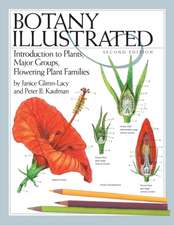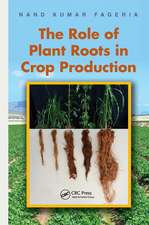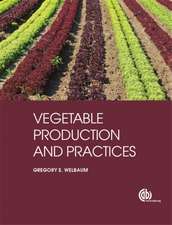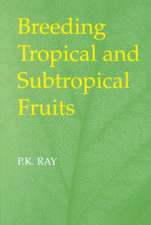Broadening the Genetic Base of Grain Legumes
Editat de Mohar Singh, Ishwari Singh Bisht, Manoranjan Duttaen Limba Engleză Paperback – 23 aug 2016
| Toate formatele și edițiile | Preț | Express |
|---|---|---|
| Paperback (1) | 944.06 lei 43-57 zile | |
| Springer India – 23 aug 2016 | 944.06 lei 43-57 zile | |
| Hardback (1) | 951.29 lei 43-57 zile | |
| Springer India – 10 noi 2014 | 951.29 lei 43-57 zile |
Preț: 944.06 lei
Preț vechi: 1151.28 lei
-18% Nou
Puncte Express: 1416
Preț estimativ în valută:
180.67€ • 187.92$ • 149.15£
180.67€ • 187.92$ • 149.15£
Carte tipărită la comandă
Livrare economică 14-28 aprilie
Preluare comenzi: 021 569.72.76
Specificații
ISBN-13: 9788132228868
ISBN-10: 8132228863
Pagini: 225
Ilustrații: X, 215 p. 6 illus., 3 illus. in color.
Dimensiuni: 178 x 254 mm
Greutate: 0.4 kg
Ediția:Softcover reprint of the original 1st ed. 2014
Editura: Springer India
Colecția Springer
Locul publicării:New Delhi, India
ISBN-10: 8132228863
Pagini: 225
Ilustrații: X, 215 p. 6 illus., 3 illus. in color.
Dimensiuni: 178 x 254 mm
Greutate: 0.4 kg
Ediția:Softcover reprint of the original 1st ed. 2014
Editura: Springer India
Colecția Springer
Locul publicării:New Delhi, India
Cuprins
1. Introduction.- 2. Common bean.- 3. Chickpea.- 4. Faba bean.- 5. Cowpea.- 6. Lentil.- 7. Pigeonpea.- 8. Groundnut.- 9. Vigna species 10. Horsegram
Notă biografică
Dr. Mohar Singh is presently working as a Senior Scientist (Plant Breeding) at the National Bureau of Plant Genetic Resources Pusa, New Delhi India. Dr Singh obtained his Doctoral degree in Plant Breeding from the Himachal Pradesh Agricultural University, Palampur, India in 2001. He has been working on genetic and genomic resources of pulses for the last 12 years. Presently, he is working on pre-breeding and genetic enhancement for breaking yield barriers in lentil and chickpea. He has identified several useful gene sources for various trait of interest in wild Cicer and Lens species and some of them have been introgressed into the cultivated background for widening the gene pool. Dr Singh has published more than 50 research papers in the journals of national and international repute like Plant Breeding, Crop Science, PLoS ONE, DNA Research, Journal of Agricultural Science, Journal of Genetics and Breeding, Genetic Resources and Crop Evolution, Plant Genetic Resources: Characterization and Utilization and Adv Hort Science and also authored two text books and one edited published by Elsevier Insights.
Dr. Ishwari Singh Bisht is working as a Principal Scientist at the National Bureau of Plant Genetic Resources (ICAR), Pusa Campus, New Delhi. As Professor of Plant Genetic Resources (PGR) discipline of Postgraduate School, Indian Agricultural Research Institute (a deemed university), he also coordinates the postgraduate teaching & research of the discipline. Dr. Bisht has been actively associated with various agro-biodiversity management issues being addressed at the national level including crop genetic resources exploration, collection, characterisation, conservation, germplasm enhancement, etc. He has been working in the field of plant genetic resources management for over 30 years and his academic achievements in this area have been widely recognized nationally and internationally. Dr. Bisht’s research mainly focuses on a thorough understandingof the factors that influence the level of crop genetic diversity maintained on-farm and addressing the complex range of factors shaping the conservation or erosion of genetic diversity in farmers’ fields. These range from farmers’ decision-making to local environmental change to interactions between and within crop populations. His research also explores modalities on mainstreaming biodiversity in production landscapes and linking biodiversity conservation to livelihood security of farmer households in small-holder subsistence farming. Dr. Bisht has also significantly contributed in PGR education addressing country’s requirement for trained manpower to carry out various biodiversity management tasks. Dr. Bisht has published 84 research papers in peer reviewed reputed journals. He is also the co-editor of a book titled “Genetic and Genomic Resources of Grain Legume Improvement” published by Elsevier in 2013.
Dr. Manoranjan Dutta is a well-known researcher and academician involved in teaching and research in the areas of crop improvement and genetic resource management for more than 30 years. He had a two years’ post doctoral research stint at the International Crops Research Institute for the Semi-Arid Tropics, India before joining the Govind Ballabh Pant University of Agriculture and Technology where he held several important positions including Professor and Head, Department of Crop Improvement; Director, Communication and Publication among others. He was the Head, Division of Germplasm Evaluation at the National Bureau of Plant Genetic Resources, ICAR from where he retired recently. Currently, he is a consultant in the Ministry of Agriculture, Govt. of India. During his long research career, he has developed 15 crop varieties, registered several genetic stocks, published more than 60 research papers in reputed international and national journals, 4 books, 17 book chapters.
Dr. Ishwari Singh Bisht is working as a Principal Scientist at the National Bureau of Plant Genetic Resources (ICAR), Pusa Campus, New Delhi. As Professor of Plant Genetic Resources (PGR) discipline of Postgraduate School, Indian Agricultural Research Institute (a deemed university), he also coordinates the postgraduate teaching & research of the discipline. Dr. Bisht has been actively associated with various agro-biodiversity management issues being addressed at the national level including crop genetic resources exploration, collection, characterisation, conservation, germplasm enhancement, etc. He has been working in the field of plant genetic resources management for over 30 years and his academic achievements in this area have been widely recognized nationally and internationally. Dr. Bisht’s research mainly focuses on a thorough understandingof the factors that influence the level of crop genetic diversity maintained on-farm and addressing the complex range of factors shaping the conservation or erosion of genetic diversity in farmers’ fields. These range from farmers’ decision-making to local environmental change to interactions between and within crop populations. His research also explores modalities on mainstreaming biodiversity in production landscapes and linking biodiversity conservation to livelihood security of farmer households in small-holder subsistence farming. Dr. Bisht has also significantly contributed in PGR education addressing country’s requirement for trained manpower to carry out various biodiversity management tasks. Dr. Bisht has published 84 research papers in peer reviewed reputed journals. He is also the co-editor of a book titled “Genetic and Genomic Resources of Grain Legume Improvement” published by Elsevier in 2013.
Dr. Manoranjan Dutta is a well-known researcher and academician involved in teaching and research in the areas of crop improvement and genetic resource management for more than 30 years. He had a two years’ post doctoral research stint at the International Crops Research Institute for the Semi-Arid Tropics, India before joining the Govind Ballabh Pant University of Agriculture and Technology where he held several important positions including Professor and Head, Department of Crop Improvement; Director, Communication and Publication among others. He was the Head, Division of Germplasm Evaluation at the National Bureau of Plant Genetic Resources, ICAR from where he retired recently. Currently, he is a consultant in the Ministry of Agriculture, Govt. of India. During his long research career, he has developed 15 crop varieties, registered several genetic stocks, published more than 60 research papers in reputed international and national journals, 4 books, 17 book chapters.
Textul de pe ultima copertă
Grain legumes play significant and diverse role in the farming systems and provide nutrition security to the largely vegetarian and relatively poorer people around the world. These are ideal crops for achieving three simultaneous developmental goals viz. reducing poverty, improving human health and nutrition, and enhancing ecosystem resilience.
Globally, grain legumes are the second most important crop group next only to cereals but a large proportion of area of it is under rainfed-low input systems as compared to cereals contributing to lower yields. The other important factor responsible for reduced yield in grain legumes is the narrow genetic base of the present day pulse varieties. In order to break the yield barriers of these cultivars, new sources of genes/ alleles need to be identified and suitably incorporated into the adapted background. The information on various aspects of grain legume improvement although has been considerable in the recent past, this information is highly scattered and not available at one place.
The present book consists of comprehensive and latest crop-wise information on important grain legumes of the world including their distribution, gene pool, systematics, status of genetic and genomic resources, production constraints, traits of importance, crop improvement methodologies - both conventional as well as contemporary, and future strategies to be adopted for comprehensive grain legume improvement in various agro-ecological target areas of the globe. The chapters have been contributed by eminent crop experts from across the world engaged in research in their respective crops for the past several years thus providing a rare insight into the crop specific constraints and prospects drawing from their rich overall experience. The book therefore will be a useful source of information to the grain legume researchers, students, policy planners and developmental experts alike.
Globally, grain legumes are the second most important crop group next only to cereals but a large proportion of area of it is under rainfed-low input systems as compared to cereals contributing to lower yields. The other important factor responsible for reduced yield in grain legumes is the narrow genetic base of the present day pulse varieties. In order to break the yield barriers of these cultivars, new sources of genes/ alleles need to be identified and suitably incorporated into the adapted background. The information on various aspects of grain legume improvement although has been considerable in the recent past, this information is highly scattered and not available at one place.
The present book consists of comprehensive and latest crop-wise information on important grain legumes of the world including their distribution, gene pool, systematics, status of genetic and genomic resources, production constraints, traits of importance, crop improvement methodologies - both conventional as well as contemporary, and future strategies to be adopted for comprehensive grain legume improvement in various agro-ecological target areas of the globe. The chapters have been contributed by eminent crop experts from across the world engaged in research in their respective crops for the past several years thus providing a rare insight into the crop specific constraints and prospects drawing from their rich overall experience. The book therefore will be a useful source of information to the grain legume researchers, students, policy planners and developmental experts alike.
Caracteristici
An updated and informative contribution to the field of cereal breeding Includes information on all the major cereal crops, from maize to sorghum to rice Comprehensively describes genetic diversity, breeding methods and techniques and integration of new biotechnology applications














